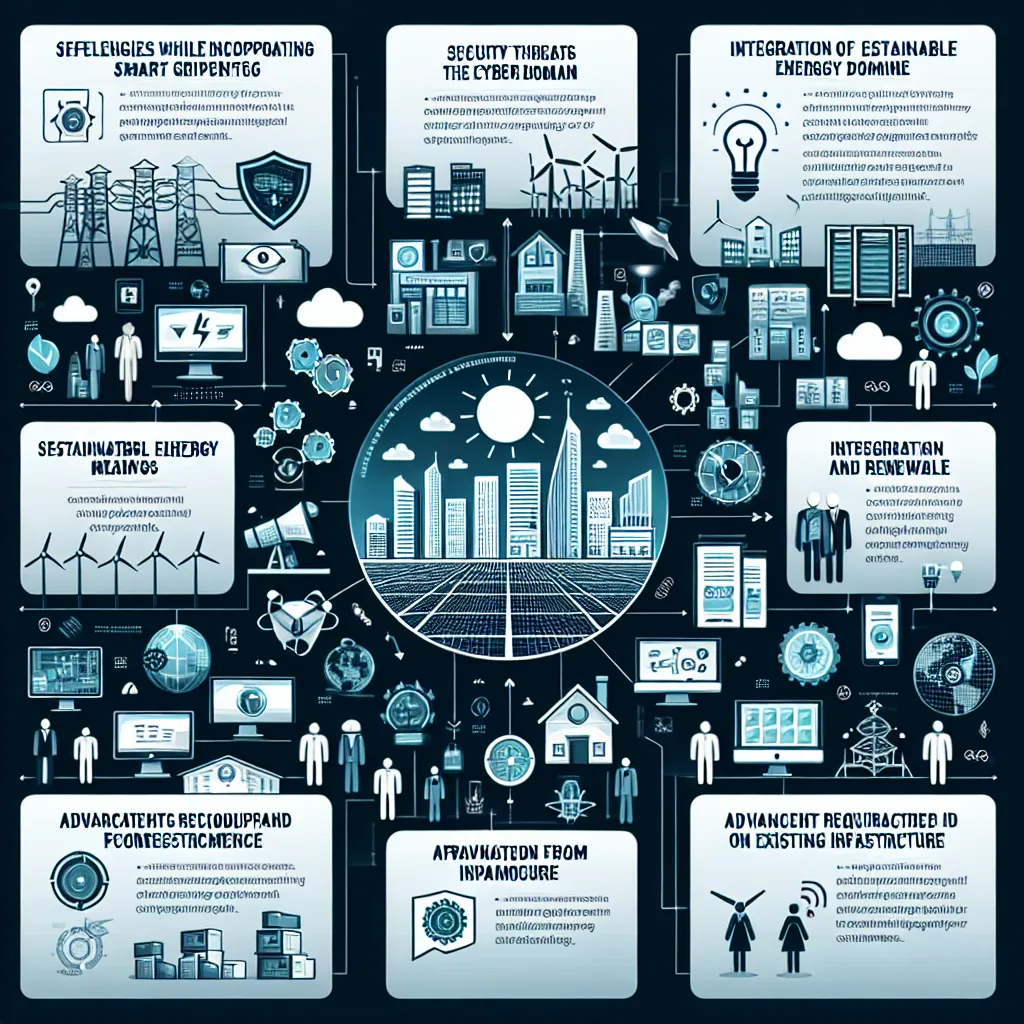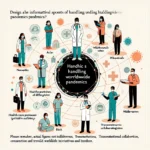Welcome to our IELTS Reading practice session focused on the topic of “Challenges in Implementing Smart Grids.” As an experienced IELTS instructor, I can assure you that understanding complex technological topics like this is crucial for success in the IELTS Reading test. The subject of smart grids has been increasingly prevalent in recent years, reflecting the growing importance of sustainable energy solutions in our modern world. Based on this trend, it’s highly likely that you may encounter similar themes in future IELTS exams.
Let’s dive into a practice passage that mirrors the style and difficulty level you might face in the actual IELTS Reading test. We’ll then explore various question types, provide detailed answers, and offer valuable insights to enhance your performance.
 Smart Grid Implementation Challenges
Smart Grid Implementation Challenges
Practice Passage: Challenges in Implementing Smart Grids
Smart grids represent a revolutionary approach to electricity distribution, offering numerous benefits such as improved efficiency, reliability, and integration of renewable energy sources. However, the implementation of these advanced systems faces several significant challenges that need to be addressed for successful deployment.
One of the primary obstacles in smart grid implementation is the substantial initial investment required. Upgrading existing infrastructure to accommodate smart grid technologies demands considerable financial resources. This includes the cost of installing smart meters, sensors, and communication networks, as well as updating control systems and software. For many utility companies and governments, justifying these upfront costs can be difficult, especially when the return on investment may take years to materialize.
Another critical challenge is ensuring cybersecurity. As smart grids rely heavily on interconnected digital systems, they become vulnerable to cyber attacks. These attacks could potentially disrupt power supply, compromise sensitive data, or even cause physical damage to infrastructure. Developing robust security measures to protect against these threats is crucial but complex, requiring ongoing vigilance and adaptation to evolving cyber risks.
Interoperability presents yet another hurdle. Smart grids involve integrating various technologies and systems from different manufacturers and generations. Ensuring that all these components can communicate and work together seamlessly is a significant technical challenge. The lack of universal standards for smart grid technologies further complicates this issue, making it difficult to achieve full interoperability across different regions or countries.
Consumer engagement and acceptance also pose challenges. Smart grids often require active participation from consumers, such as adjusting their energy consumption patterns or adopting new technologies like smart home devices. However, many consumers may be resistant to change, concerned about privacy issues related to data collection, or simply unaware of the benefits of smart grids. Educating and motivating consumers to embrace these new systems is crucial for their success.
The integration of renewable energy sources, while a key benefit of smart grids, also presents challenges. The intermittent nature of renewable energy, such as solar and wind power, requires sophisticated management systems to balance supply and demand effectively. This includes developing advanced forecasting techniques, energy storage solutions, and flexible grid management strategies.
Regulatory frameworks and policies also need to evolve to support smart grid implementation. Many existing regulations were designed for traditional power systems and may not adequately address the complexities of smart grids. Updating these regulations to encourage innovation while ensuring fair competition and consumer protection is a delicate balance that policymakers must strike.
Lastly, the technical complexity of smart grids requires a skilled workforce for their implementation and maintenance. There is often a shortage of professionals with the necessary expertise in areas such as power systems engineering, data analytics, and cybersecurity. Training and developing this workforce is essential but takes time and resources.
In conclusion, while smart grids offer significant potential to transform our energy systems, their implementation is fraught with challenges. Addressing these obstacles requires coordinated efforts from governments, utilities, technology providers, and consumers. As solutions to these challenges are developed and refined, the path to widespread smart grid adoption will become clearer, paving the way for a more efficient and sustainable energy future.
Questions
True/False/Not Given
Determine whether the following statements are True, False, or Not Given based on the information in the passage.
- Smart grids are more efficient and reliable than traditional power distribution systems.
- The initial cost of implementing smart grids is the only significant financial challenge.
- Cybersecurity threats to smart grids can potentially cause physical damage to infrastructure.
- All countries have adopted universal standards for smart grid technologies.
- Consumer resistance to smart grid adoption is primarily due to lack of information.
Multiple Choice
Choose the correct letter, A, B, C, or D.
-
According to the passage, which of the following is NOT mentioned as a challenge in implementing smart grids?
A) High initial costs
B) Cybersecurity risks
C) Environmental impacts
D) Interoperability issues -
The passage suggests that the integration of renewable energy sources in smart grids is challenging because:
A) Renewable energy is too expensive
B) It requires sophisticated management systems
C) Consumers don’t want renewable energy
D) It’s not compatible with existing infrastructure
Matching Headings
Match the following headings to the appropriate paragraphs in the passage. You may use each heading only once.
- Financial Barriers
- Security Concerns
- Technical Integration Challenges
- Public Participation Issues
- Workforce Development Needs
Short Answer Questions
Answer the following questions using NO MORE THAN THREE WORDS from the passage.
- What type of professionals are in short supply for implementing and maintaining smart grids?
- What needs to evolve to support smart grid implementation in terms of governance?
- What is crucial for balancing supply and demand in smart grids that integrate renewable energy sources?
Answers and Explanations
True/False/Not Given
- True – The passage states that smart grids offer “improved efficiency, reliability, and integration of renewable energy sources.”
- False – The passage mentions other financial challenges, such as “justifying these upfront costs” and the fact that “return on investment may take years to materialize.”
- True – The passage explicitly states that cyber attacks “could potentially disrupt power supply, compromise sensitive data, or even cause physical damage to infrastructure.”
- False – The passage mentions “The lack of universal standards for smart grid technologies.”
- Not Given – While the passage mentions that consumers may be “unaware of the benefits,” it does not state this as the primary reason for resistance.
Multiple Choice
- C – Environmental impacts are not mentioned as a challenge in the passage.
- B – The passage states, “The intermittent nature of renewable energy, such as solar and wind power, requires sophisticated management systems to balance supply and demand effectively.”
Matching Headings
- Financial Barriers – Paragraph 2
- Security Concerns – Paragraph 3
- Technical Integration Challenges – Paragraph 4
- Public Participation Issues – Paragraph 5
- Workforce Development Needs – Paragraph 8
Short Answer Questions
- Skilled workforce
- Regulatory frameworks
- Advanced forecasting
Common Mistakes and How to Avoid Them
-
Overlooking key phrases: Always pay attention to qualifiers like “only,” “primarily,” or “all” in True/False/Not Given questions. These can change the meaning of a statement significantly.
-
Making assumptions: Stick to the information provided in the passage. Avoid bringing in external knowledge or making inferences beyond what’s stated.
-
Misinterpreting “Not Given”: Remember, “Not Given” means the information is neither confirmed nor denied in the passage.
-
Rushing through the passage: Take time to understand the overall structure and main ideas of each paragraph. This helps in answering questions like Matching Headings more accurately.
-
Copying too many words: For short answer questions, be precise and use only the words from the passage. Practice identifying key phrases quickly.
Vocabulary Focus
- Implementation: (noun) the process of putting a plan or system into effect
- Intermittent: (adjective) occurring at irregular intervals; not continuous or steady
- Interoperability: (noun) the ability of computer systems or software to exchange and make use of information
- Vigilance: (noun) the action or state of keeping careful watch for possible danger or difficulties
- Resilience: (noun) the capacity to recover quickly from difficulties; toughness
Grammar Spotlight
Pay attention to the use of conditional statements in the passage, such as:
“These attacks could potentially disrupt power supply, compromise sensitive data, or even cause physical damage to infrastructure.”
This structure (could + verb) is used to express possibility or potential outcomes. It’s commonly used in academic and technical writing to discuss hypothetical situations or future possibilities.
Expert Tips for IELTS Reading Success
-
Practice active reading: As you read, mentally summarize each paragraph. This improves comprehension and retention.
-
Improve your vocabulary: Regularly learn new words related to technology, environment, and energy. These topics are frequent in IELTS tests.
-
Time management: Allocate your time wisely. Spend about 20 minutes on each passage in the Reading test.
-
Skim and scan effectively: Quickly identify key information without reading every word. This skill is crucial for time management.
-
Stay informed: Read articles on current affairs, especially those related to technology and environmental issues. This background knowledge can be invaluable in understanding complex passages.
Remember, success in IELTS Reading comes with consistent practice and a strategic approach. Keep challenging yourself with diverse reading materials and practice tests. Good luck with your IELTS preparation!
For more practice on related topics, check out our articles on urban planning and sustainability in smart cities and AI’s role in developing smart infrastructure. These will provide additional context and vocabulary that could be useful in your IELTS preparation.


